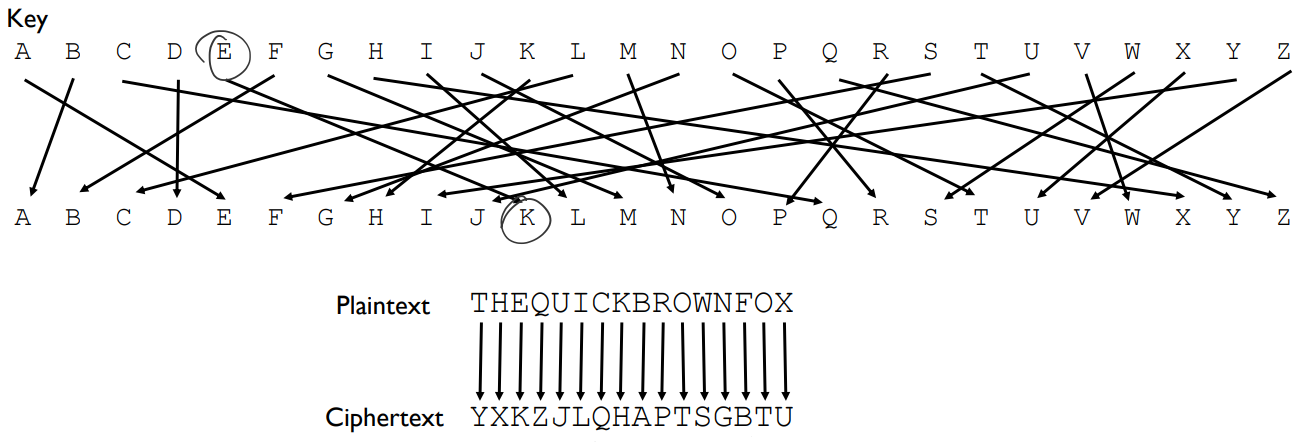Crpytography 1 -- Historical Ciphers & Cryptanalysis
This is a learning note of a course in CISPA, UdS. Taught by Nico Döttling
Substitution Ciphers (∼?)
- One of the oldest cipher in the world, used in the bible (Atbash)
- Reorder the alphabet list to create a substitution list
- Number of keys: $26!$

Shift Cipher
- Create the substitution list by shifting the alphabets
- Each letter in the plaintext is replaced by a letter some fixed number (key) of positions down the alphabet.
- Number of keys: $26$
Caesar Cipher (∼70 BCE)
- A speical form of shift cipher
- shift left by exactly 3 (key = 3)

The Vigenère Cipher (∼1500)
- Variant of Shift Cipher, called Polyalphabetic cipher
- Every character (can) shift independently
- Different character can be encrypted as same character
- Usually only use a repeating word/phrase as a key instead of encrypt every character one by one
- First create a word, e.g. MOTH
- Shift
- Number of keys: $26^{n}$

Cryptanalysis of the Vigenère Cipher
- Cryptanalysis is the science of breaking codes and deciphering encrypted messages without knowing the key or the encryption algorithm
- Can we guess the key/plaintext by investigating the Ciphertext?
Known knowledge of Vigenère Cipher
- Vigenère Cipher is a shift cipher with substrings (key)
- Key length is a secret
- Need to first guess the key length before guessing the key itself

Kasiski examination
- Find the duplicate phrase/strings that appeared in the ciphertext
- Calculate the distance between two phrase to deduce the key length

- In the example, the distance between the two V in VHVS is 18, and the distance is 30 for Q in QUCE
- The common factors of 18 and 30 are 1, 2, 3, 6
- We can guess the key length as 6, since 1, 2, 3 may be too short for a key
Frequency Analysis
- Every langauge has a pattern/frequency of the characters used
- A short piece of text (should) show a similar distribution as the language as a whole
- We can split the text based on the key length we are guessing
- e.g. 12341234… $\Rightarrow$ 111…222…333…444..
- Now each set of letters are simple shift cipher
- apply frequency test by shifting them step by step
- if they show similar frequency pattern, there is a high chance that it is the correct encrpytion (Friedman test)


Cryptanalysis of the Substitution Cipher
- Using Frequency Analysis on alphabet, we can only those who have highest/lowest frequency
- Natural language also has frequent character constellations
- Generalize character frequencies: Bigrams, trigrams, …N-grams

- Plaintext recovery requires a lot of context information and guessing
- strongest possible attack
- Language? Context?
Extreme Case: 1 Ciphertext, 2 Plaintexts
- Guess which plaintext is encrypted into the ciphertext
- Structural Property of Cipher: Same letters always encrypt to same letter

Some Lessons from Historic Ciphers
- Ciphers without keys or small key-space cannot recover from compromise
- Ciphertext should not reveal statistical information about plaintexts
- Further thoughts: Many historic ciphers immediately broken given a single message-ciphertext pair
Kerkhoff’s Principle
The cipher method must not be required to be secret, and it must be able to fall into the hands of the enemy without inconvenience.
- Designs which violate Kerkhoff’s principle = achieve Security by Obscurity
- Nowadays obscurity is considered bad cryptographic design
- It is easier to switch a compromised key than a compromised design
Next post: Probability Theory
Further Reading: History of cryptography
Crpytography 1 -- Historical Ciphers & Cryptanalysis